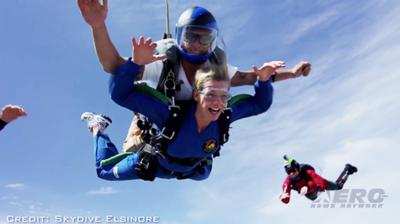Fewest Fatalities Since Association Began Keeping Records In 1961
The United States Parachute Association (USPA) reports that in 2018, 13 people died during skydives in the U.S. This is the lowest annual fatality number since 1961, when USPA (then the Parachute Club of America) began keeping statistics. That year, 14 jumpers died, and the number of fatalities steadily increased for the next two decades before they began to drop in the early 1980s. Considering the increase in skydiving activity over the last 57 years, this is a phenomenal achievement.

The comparison is staggering: In 1961, the estimated fatality rate was one fatality for every 9,000 parachute jumps; the fatality rate for 2018 was one fatality for every 253,669 parachute jumps. These numbers, including the fatality count, include only non-military skydives, since USPA tracks only sport jumps.
Although this number is likely an anomaly and fatalities in future years may approach the decade’s average of around 21, we can be hopeful, especially since the average number of fatalities has slowly dropped over time. This is a true testament to daily, industry-wide efforts to reduce the risks of skydiving. Improvements in equipment, training programs, drop zone management and the overall awareness and vigilance of licensed skydivers have combined to reduce the fatality rate to a minor percentage of the annual rates of previous decades.
Although fatality rates have drastically improved, sadly, skydivers continue to repeat the mistakes of those who died in the past. The basics of surviving each skydive never really change, but skydivers are human beings and, as such, are capable of human error. A successful skydive requires a freefall with no high-speed collisions; a main parachute deployment at a safe altitude in clear airspace; a timely response in the event of a main-parachute malfunction; a reasonably slow and soft parachute opening; and a landing with the wing level, at a low descent rate and into an area free of obstacles.

Each year, USPA publishes this report, which examines the previous year’s fatal accidents and compares them with other years to help identify trends and problem areas. This helps to determine where to focus efforts toward educating skydivers and how to develop changes to equipment or regulations. The lessons learned have resulted in changes to skydiving equipment, training methods, drop zone culture and other areas, which have all helped to reduce fatalities over the years.
Every fatality is a result of a series of events that combine to create a fatal outcome. Many of the causes are obvious, while others are subtler but still play a significant part. In 2018, several fatalities involved skydivers with relatively low experience levels using equipment suitable for more advanced skydivers. Whether downsizing to smaller, high-performance parachutes or upsizing to more complex tracking suits and wingsuits, skydivers need to spend more time training with slower, less-advanced equipment before moving to more advanced gear. Impatience and an unwillingness to spend the time to properly prepare for the next level can be fatal.
Parachute and jumpsuit manufacturers provide recommendations for the experience level necessary to use their equipment. USPA developed Basic Safety Requirements to set experience minimums for wingsuit first flights. USPA also provides experience recommendations for various canopy designs and wing loadings, as well as wearing a camera. These rules and recommendations are based on research that comes from accident data. Skydivers would be wise to seek out proper training and mentoring and to follow these guidelines before using any new piece of skydiving equipment.
Overall, skydiving is safer than ever. The collective efforts of USPA, skydiving equipment manufacturers, coaches, instructors, examiners, Safety and Training Advisors, parachute riggers, drop zone owners and skydivers themselves have combined to produce an all-time low in the number of fatal accidents. By studying the fatal accidents from previous years and learning from them, skydivers can improve their situational awareness. Each skydiving fatality is a tragedy, and the least we can do is use the information we learn from each fatality to improve the level of safety and continue to reduce the number of fatal accidents.
(Source: USPA. Images from file)
 ANN FAQ: Contributing To Aero-TV
ANN FAQ: Contributing To Aero-TV ANN's Daily Aero-Linx (05.29.24)
ANN's Daily Aero-Linx (05.29.24) ANN's Daily Aero-Term (05.29.24): NORDO (No Radio)
ANN's Daily Aero-Term (05.29.24): NORDO (No Radio) ANN's Daily Aero-Term (05.30.24): Beyond Visual Line Of Sight (BVLOS)
ANN's Daily Aero-Term (05.30.24): Beyond Visual Line Of Sight (BVLOS) ANN's Daily Aero-Linx (05.30.24)
ANN's Daily Aero-Linx (05.30.24)




